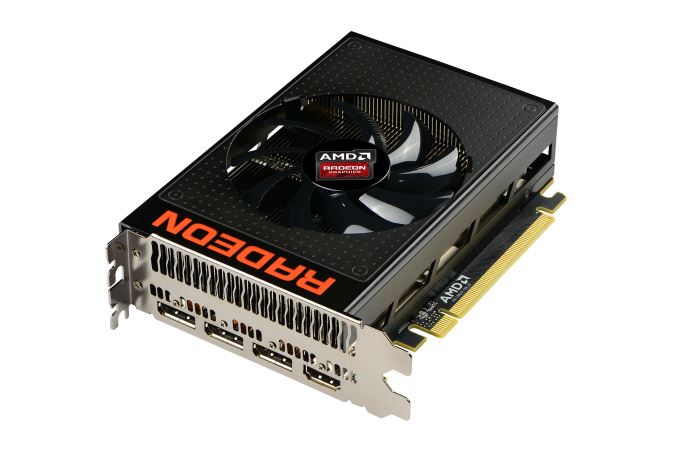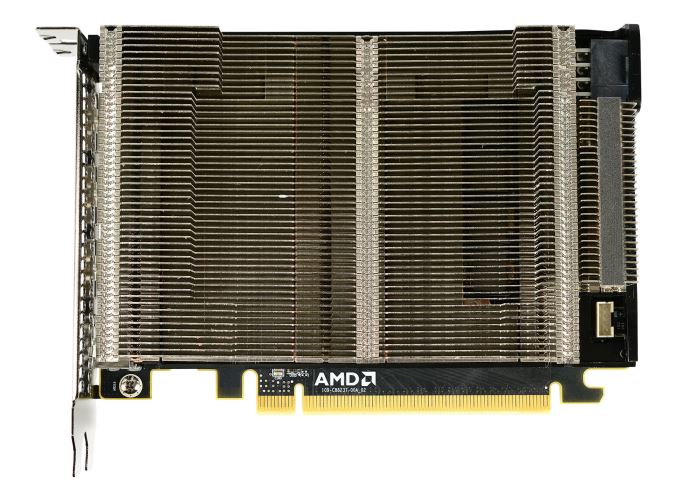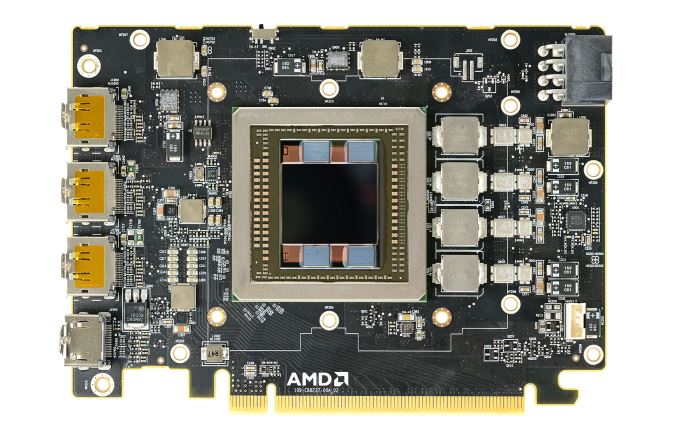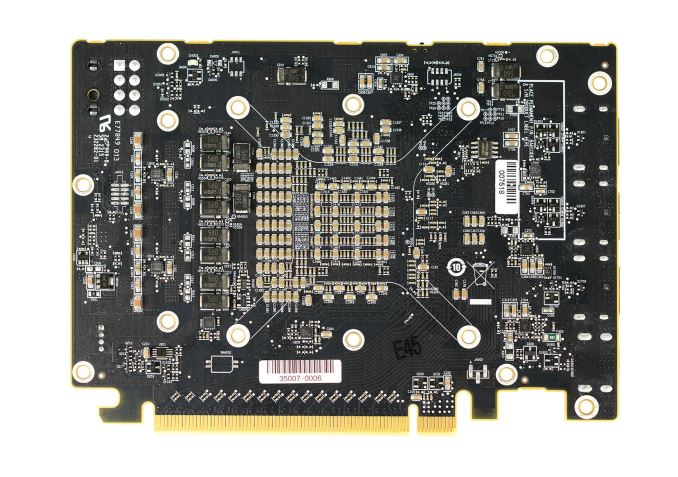The AMD Radeon R9 Nano Review: The Power of Size
by Ryan Smith on September 10, 2015 8:00 AM ESTMeet The Radeon R9 Nano
6 inch video cards are by no means a new thing in the GPU space, however these are traditionally lower-end products that need neither a large cooler nor an extensive power delivery system. As a result the R9 Nano is something of an interesting aberration, packing a lot more power and a lot more technology into half a foot of video card than what we normally see.
Starting as always from the top, the R9 Nano measures 6” long, which is actually a bit shorter than the full length the Mini-ITX standard allows. Responsibility for cooling the card falls to the R9 Nano’s new open air cooler, an aggressive design that has been specifically tailored to allow the card to effectively dissipate 175W of heat in such a small space.
The overall design of the R9 Nano’s cooler is best described as a combination open-air and half-blower hybrid. The design is technically open-air, employing a single axial fan to cool the card. However with only a single fan AMD has been able to align the heatsink fins horizontally and then place the fan in the center of the heatsink. The end result is that roughly half of the heat produced by the card is vented outside of the case, similar to a full blower, while the other half of the heat is vented back into the case. This reduces (though doesn’t eliminate) the amount of hot air being recycled by the card.
The heatsink itself is composed of aluminum and runs virtually the entire length of the card. This is technical a two-piece heatsink, with the primary heatsink composing the bulk of the card, while a much smaller secondary heatsink it found towards the far end of the card and mounted on top of a heatpipe.
Drilling down, we find that the primary heatsink is fed by a combination vapor chamber and heatpipe design. A copper vapor chamber serves to draw heat away from the Fiji GPU and HBM stacks, and then heatpipes are used to better distribute heat to the rest of the heatsink. The use of a vapor chamber in the R9 Nano makes a lot of sense given the fact that vapor chambers are traditionally the most efficient heatsink base type, however the R9 Nano is also unique in that we typically don’t see vapor chambers and heatpipes used together. Other designs such as the high-end GeForce series use a single large vapor chamber across the entire heatsink base, so among reference cards at least the R9 Nano stands alone in this respect. In this case given AMD’s design goals for size and noise, a vapor chamber will play a big part in helping the small card effectively and quietly dissipate 175W.
As for the physical PCB itself, as we can see AMD made it a relatively packed card in order to get the R9 Nano down to 6 inches. Compared to the R9 Fury X reference board, the biggest change here is that AMD has removed a fair bit of power circuitry to save space. By our count there are 4 VRM phases to feed the Fiji GPU, as opposed to the 6 found on R9 Fury X. Power delivery is handled by a single 8-pin PCIe power socket, which is becoming increasingly common, replacing the 2x 6-pin setup for 150W-225W cards.
Meanwhile to further shrink the overall PCB footprint, AMD has moved some of the remaining power delivery circuitry to the back of the card. The front of the card still contains the inductors and heat-sensitive MOSFETs, while a number of capacitors are on the rear of the card (and is why you won’t find a backplate).
Finally, for display I/O R9 Nano is unchanged from R9 Fury X. This means we’re looking at a DVI-free design, with 3x DisplayPort 1.2 and 1x HDMI 1.4 port all along a single row of the I/O bracket. Buyers looking to put together HTPCs will want to be especially mindful of the HDMI 1.4 port; while it's not necessarily a deal-breaker, it does mean that the R9 Nano can't fully drive 4Kp60 TVs, which are slowly but surely becoming more common.
Overall AMD is rather confident in their design for the R9 Nano. The heatsink is built to efficiently dissipate more heat than the 175W the card requires (despite the small size), and as a result we never see the R9 Nano thermally throttle under normal operation. The card’s thermal throttle point is 85C, and in our testing the card never passed 75C, exactly as AMD promised us. What ends up limiting the R9 Nano’s performance then is exactly as expected: the power throttling.
















284 Comments
View All Comments
Jm09 - Friday, September 11, 2015 - link
Yes I'm aware, but the nano is binned for the highest quality chips. I wish they would of released two models where one was clocked lower and didn't have binned chips. That alone increased the price of this chipMaddyScientist - Thursday, September 10, 2015 - link
It would be nice to use the latest version of LuxMark 3.1, as this has optimizations for both AMD and NVIDIA GPUs, that makes it run faster on more recent GPUs. This would would give a better picture of the compute benefits of these new GPUS.at80eighty - Friday, September 11, 2015 - link
Ryan, i realise it's a test bench, but that cable management is making me twitchy :)Ryan Smith - Friday, September 11, 2015 - link
Noted and agreed. It wasn't really built for public display, it was thrown together for video recording. Small computers are nice, but they're hard to quickly route cables in, especially with my giant hands.awstar - Friday, September 11, 2015 - link
Review > Compute > Vegas: The Vegas benchmark has peaked. The reviewers should post stats on timeline playback performance, or upgrade the test file to 4K XAVC 32-bit float project levels. This would show a much greater difference between the modern GPUs.Haravikk - Friday, September 11, 2015 - link
It's great to see a card like this; finally a proper high end for half-length cards. While there are some good Mini-ITX cases that can take full-length cases, they end up so long that it kind of defeats the point of building small, but half-length cards are usually more in the budget to mid-range bracket, or a generation behind, either way it means a big sacrifice in going small.Hopefully we'll see more competition in this case, as I'm one of those who, in going small, is fine with paying a premium to still remain fairly competitive while doing so.
Regarding the idle noise level though; I still find it weird that there isn't better support out there for switching from integrated to discrete GPUs. Since most people still favour Intel processors this would make a lot of sense given that they have integrated graphics, plus in the Mini-ITX size on the AMD side it can be more cost effective to get an APU anyway. If the integrated GPU could take over for desktop stuff, browsing etc. like we see on laptops, then it would leave the Nano to just function as a set of video interfaces, which would be much better.
Alternatively, I wonder if they could even just add an APU type GPU as a low-power alternative onto the card; i.e- with a light load and low VRAM requirements it would take over and just use some low cost RAM (or even system RAM) so that the rest of the card can be shut off entirely.
Peichen - Friday, September 11, 2015 - link
Modern graphic card only draws single-digit watt power at idle/2D so the whole hybrid GPU idea was dropped. Routing video through integrated GPU also reduce performance by 2-3% and taken into account the complexity involved with driver just to save 8w makes no sense.atomsymbol - Friday, September 11, 2015 - link
R9 Nano: 4096 SP, 1 GHz, 512 GB/s => x+5 FPS, price y+$220R9 390X: 2816 SP, 1.05 GHz, 384 GB/s => x FPS, price y
+35% computational power => +5 FPS
Mathos - Friday, September 11, 2015 - link
After having read this review. All I can really think of to say about the Nano, is they should of priced it at least the same as the regular R9 Fury. That way you'd easily get GTX 980 performance in a itx form factor, for close to the same price. I must say your review seems a bit more fair than Toms hardware. Somehow they had a regular 980 outperforming the FuryX, so I was like wth Toms.I personally had been waiting for the Nano reviews to come out, before deciding what to get. But going by the price, it looks like I'll be getting an R9 Fury, so I can run most games in VSR 1440p, scaled down to 1080p. Either that or I'll just cap my fps at 65 and save power. Should do well once more DX12 games come out too.
itproflorida - Friday, September 11, 2015 - link
you have no idea what your talking about its all speculation. thank you